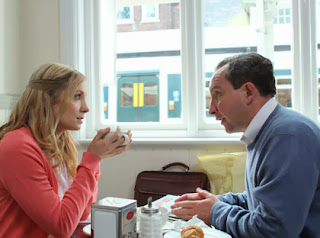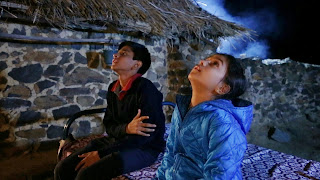It is not often that you come across a film that looks innocuous at its beginning and then develops gradually into a truly uplifting and amazing work of cinema.
Still Life is a
tale of a lower-rung British civil
servant John May (his name could well have been John Doe in the US or Joe
Bloggs in the UK ), unmarried and yet married to his job with a diligence that
makes our own attitudes to work in offices (and homes) look a tad
unprofessional in comparison. The name
John May sounds as colorless as is the individual that the director and
original screenplay writer Uberto Pasolini gets actor Eddie Marsan to play. The
incredible character is a lonely chap working in a small office in UK all alone with files all
neatly stacked just as neat and orderly is his small desk with a phone. And Marsan and Pasolini get around to develop
such a colorless individual that some unsuspecting viewers of the movie assumed that the film would be as drab as the character and were seen walking
out of the film halfway misled by its quiet beginning. And what a lovely film they missed out on!
Marsan is able to slip into the role of the loner, who ensures that all lonely individuals who die in his official jurisdiction get a proper burial after taking great pains to locate any possible kith and kin to attend the funeral, by either calling up people on the phone or ever visiting addresses he finds in the deceased’s residence. (Marsan had earlier played minor but important roles in Scorsese’s The Gangs of New York, Iñárritu's 21 Grams and Malick’s The New World.). Marsan, who never smiles in the film, does smile once in the film and what an occasion that is!
Marsan is able to slip into the role of the loner, who ensures that all lonely individuals who die in his official jurisdiction get a proper burial after taking great pains to locate any possible kith and kin to attend the funeral, by either calling up people on the phone or ever visiting addresses he finds in the deceased’s residence. (Marsan had earlier played minor but important roles in Scorsese’s The Gangs of New York, Iñárritu's 21 Grams and Malick’s The New World.). Marsan, who never smiles in the film, does smile once in the film and what an occasion that is!
When May returns to his apartment from work, the viewer is presented a neat
and orderly place with the bare essentials, and one even gets to see him eating
a meager meal of toast and canned fish. And we also learn that he has been repeating this for the past 20 odd years, and believe it or not, enjoying both his work and his spartan meals.
However, the director Pasolini leaves a crumb trail for the perceptive viewers.That trail, which looks innocuous, is only building up to something
unusual, as intelligent viewers would expect. And that Pasolini does deliver at the end of the film, and it's a finale that
would make you revisit the earlier scenes with your mind’s eye afresh and enjoy it all
over again.
Who is Pasolini? He is no relation of the famous filmmaker
Pier Paolo Pasolini. Interestingly, he is
a descendant of famous Italian director Luchino Visconti and is a real life Count, if Wikipedia, is to be believed,
and he has worked his way up the movie ladder after being the third Assistant
Director for Rolland Joffe’s The Mission (1986), the producer of The Full Monty (1997) and director of Machan (2008), his debut film that
picked up a few minor awards worldwide.
Pasolini in Still Life
makes visual statements that border on the comical but is never funny in the conventional sense of fun.
These statements are thought provoking and real. Early in the film, the viewer sees empty
churches of various Christian denominations where the priest solemnly conducts a brief
funeral service and even reads out a few words of praise about the deceased. We
subsequently learn that those words spoken by the priest are actually provided by May after painstakingly going through the deceased’s living quarters like a detective and speaking to people who knew
the person when he or she was alive. Mr May is often the only
individual present at each of these funerals.
But May ensures that the dead do get a fitting funeral at the cost of the
town's exchequer.
The person sitting behind me in the movie hall was heard commenting: “Look at
the empty churches,” mistakenly assuming the visual commentary of the director was on religion. But Still Life
is not a film about religion but about old age and the lack of friends and
family in the evening of our lives. Even when John May contacts the deceased's relatives and friends they rarely bother to attend the funeral. It is a film that looks at relationships both in life and upon death. It is a film about the uncertainty of our jobs,
of being served the pink slip even when you are the ideal worker. It is a film
that reminds you that you cannot take tomorrow for granted.
Still Life is also
a film about essentially good people who remain unmarried and without friends and yet ought to be be be considered as persons who add value to society . Director Pasolini has proven one fact: you can make great cinema if
you have a great script with a positive tale and a wonderful performance by an actor such as Eddie Marsan. And
Pasolini has a talented composer of music to make the movie even more
delectable, his wife Rachel Portman, who had earlier regaled our ears while
watching Swedish film director Lasse Halstrom’s two notable works Chocolat (2000) and The Cider House Rules (1999). The power
of Ms Portman’s music in Still Life keeps
pace with the development of the film’s story and, if the viewer pays attention to
the subtle progression in the music, one can anticipate an extraordinary end. The film’s end and the final chords
of Ms Portman’s music are truly memorable.
Now Still Life could
appear to be a very simple film to many viewers but is it? Still Life captures visual details
that can be considered humorous, sofa chairs propped up by books (shown twice
in the film), what the elderly consider a
great meal on two occasions in the film is toast and canned fish, and when a young
man in the mortuary is searching for a four letter world combining death and
animal, John May is quick with the correct answer “dodo.” Visuals in the film are brilliant
and evocative: closed curtains of apartment buildings so that no one knows what
is happening in another neighbor’s home,
old people looking out of balconies day
after day in a vacant manner, streets that seem to empty without children or young couples. It is indeed a Still Life
that Pasolini picks to project as a slice of modern England. It is a life where people don’t
care about the others. It is a life where officials are quick to spot jobs that can be logically considered redundant in modern society to save money, oblivious of how well someone is executing that particular job, and of the larger value of the job that makes an otherwise drab life colorful, even if the job deals with death of many unsung individuals who fade out without a song. It is a
tale that reinforces the fact that the most unimpressive persons can change
lives of others if they care to do so–a subject that British director Stephen
Frears tried to grapple with limited success in Hero (1992) with Dustin Hoffman playing the lead. It is a British
film to the core as it looks at its staid bureaucracy, but with a difference, and it is an European film because Pasolini injects a typical European way to dissect the British
subjects, with love and a twinkle in the eye. It has propped up the dwindling British cinema recalling the finer examples of the late Joseph Losey's cinema.
Pasolini’s Still Life
is a remarkable film bolstered by an amazing screenplay, astute direction, credible acting and appropriate music. It
is the finest film of 2013 that entertains and uplifts the mind of the viewer and
it is great to know that there is yet another Pasolini in the world of cinema
that matters! It is also a film that shows a director can grow in expertise
from film to film as in the case of the Polish maestro Kieslowski who bloomed
towards the end of his career. However, it is essential that the viewer watches the film
right up to the end to grasp and relish the film’s quiet strength. It was one of the few films that received a standing ovation after the film ended from the knowledgeable audience at the recently concluded International Film Festival of Kerala. Uberto Pasolini had indeed made an impact with those who stayed to watch the film right up to the end.
P.S. Still Life is the best
film of 2013 for this critic. It won several minor awards at the 2013 Venice
film festival and the award for the best film at the Reykjavik film festival. Still Life won the Black Pearl award (the highest award) at the Abu Dhabi film festival's New Horizons section for "its humanity, empathy, and grace in treating grief, solitude, and death." The citation went on to add "The film lured us with its artistic sensibility, subtleness, intelligence, humor, and its unique cinematic language." Mr Marsan won the Best British Actor award at the 2014 Edinburgh International film festival. Still Life won the Grand Prix and the Best Actor award at the rapidly emerging 2014 VOICES film festival at Vologda, Russia. The film, The Mission, in which Mr Pasolini served as the Third Assistant Director was reviewed earlier on this blog.
P.P.S. The author was delighted to receive a personal "thank you" email from the director of the film Still Life, just weeks after the above review was posted on the internet. The author had neither met nor contacted Mr Pasolini prior to receiving his email.
P.P.S. The author was delighted to receive a personal "thank you" email from the director of the film Still Life, just weeks after the above review was posted on the internet. The author had neither met nor contacted Mr Pasolini prior to receiving his email.






































